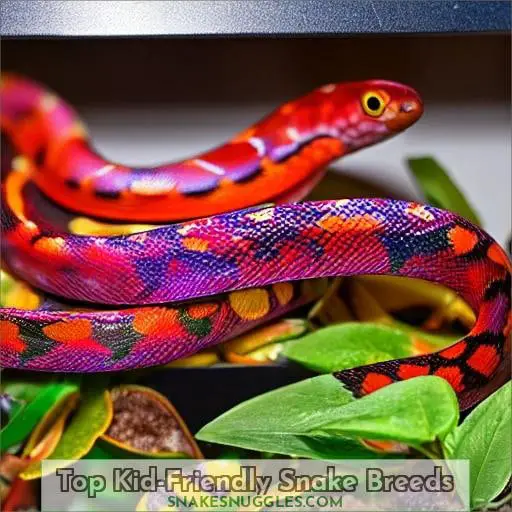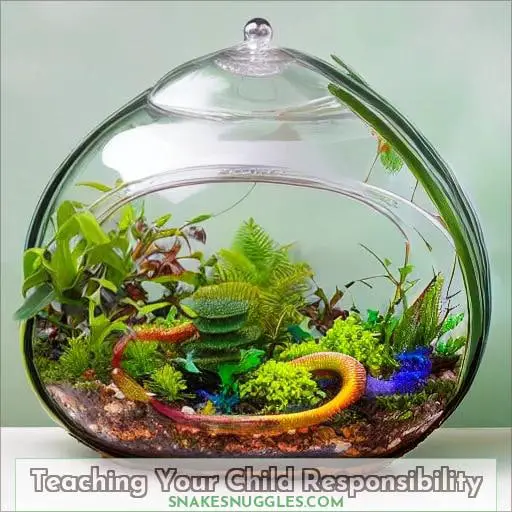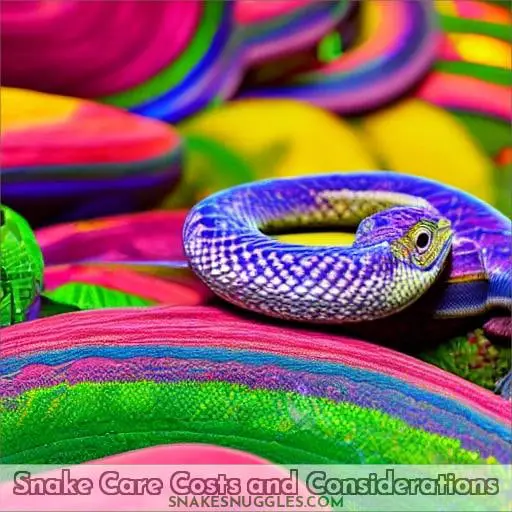This site is supported by our readers. We may earn a commission, at no cost to you, if you purchase through links.
 Safe, Easy Pets to Care For:
Safe, Easy Pets to Care For:
You’re curious about bringing a slithering new friend into the family. Excellent idea!
With the right preparation and species selection, a snake can be an engaging, low-maintenance pet for kids.
Let’s explore top beginner breeds like corn snakes and ball pythons.
We’ll cover proper handling, habitats, feeding, and more so your child can enjoy a safe, rewarding bond with these fascinating creatures.
Read on for tips from a seasoned herpetologist on choosing the perfect kid-friendly snake.
Table Of Contents
- Key Takeaways
- Choosing the Best Pet Snake
- Top Kid-Friendly Snake Breeds
- Caring for Your Pet Snake
- Kid-Friendly Snake Species to Avoid
- Setting Up the Perfect Snake Habitat
- Keeping Your Snake Healthy
- Teaching Your Child Responsibility
- Snake Care Costs and Considerations
- Fun Facts About Kid-Friendly Snakes
- Frequently Asked Questions (FAQs)
- What should I do if my child gets bitten by the pet snake?
- How can I find a good exotic pet veterinarian to care for my child’s snake?
- What signs should I look out for if the snake escapes from its enclosure?
- Are there any snake breeds that can be handled safely by very young children under 5 years old?
- What are fun and creative ideas to decorate the snake’s habitat to keep my child engaged?
- Conclusion
Key Takeaways
- Prioritize safety by choosing docile, beginner-friendly snake breeds like corn snakes, king snakes, milk snakes, ball pythons, or California kingsnakes.
- Conduct thorough research on proper habitat setup, handling techniques, feeding schedules, and overall care responsibilities before getting a pet snake.
- Involve children in gentle handling and husbandry tasks under supervision to teach responsibility and respect.
- Find an exotic veterinarian, set up annual checkups, and monitor the snake’s health to ensure proper care.
Choosing the Best Pet Snake
As you consider getting a pet snake for your child, safety should be your top priority.
Focus your search on docile, beginner-friendly snake breeds that are unlikely to bite or constrict.
With proper research and preparation, snakes can make excellent first pets that are easy for kids to care for.
Safety Considerations
Consider safety first when choosing a pet snake for your child.
Learn proper handling techniques to avoid bites or constriction.
Ensure secure habitat latching to prevent escapes.
Closely monitor the snake’s health and watch for signs of illness.
Educate family on snake behaviors and needs for approval.
Select a non-venomous, gentle breed suitable for beginners.
Research proper care to provide a safe, enriching environment.
Beginner-Friendly Breeds
Once you decide on getting a pet snake for your kids, look into corn snakes and king snakes.
When beginning your snake handling journey, start by creating a safe habitat. Include proper substrates and enrichment elements to support natural behaviors.
Popular starter snakes like milk snakes, corn snakes, ball pythons, California kingsnakes, and garter snakes make ideal, docile companions.
Top Kid-Friendly Snake Breeds
When choosing the best pet snake for kids, three popular options stand out:
Corn snakes
Ball pythons
Kingsnakes
These three snake breeds are typically docile, stay a reasonable size, and have straightforward care requirements that are manageable for young owners.
Before bringing one home, research the specific needs of each breed to determine which is the best fit for your family.
Corn Snakes
Since corn snakes are docile, easy to care for, and remain a modest size, they’re one of the best pet snake choices for kids.
Provide climbing branches so they can explore.
When shedding, create a humid hide.
Feed thawed pinkies.
Gently handle frequently so they become comfortable around children.
Their orange-red bands resemble Indian corn, inspiring their name.
Ball Pythons
Safe, Easy Pets to Care For:
Why are ball pythons considered a top kid-friendly snake breed?
Their calm temperament and manageable size make them an excellent choice.
Shedding Insights:
Help them during shedding by providing a humid hide.
Feeding Frenzy:
Offer an appropriately sized frozen/thawed mouse weekly.
Habitat Harmony:
Give them plenty of hides and branches for climbing.
Handling Hues:
Support their body gently when handling their vibrant colors.
Kingsnakes
As you’re exploring top kid-friendly snake breeds, consider kingsnakes with their vivid patterns and typically calm dispositions.
Here are some key details about kingsnakes as pets for kids:
Trait: Handling Techniques
Description: Allow exploratory movement when handled, provide secure grip
Example: Support body, don’t restrain head
Trait: Colorful Varieties
Description: Diverse color morphs from jet black to vibrant red
Example: Albino, lavender, desert phase
Trait: Educational Benefits
Description: Observe hunting behaviors, shedding process up close
Example: Identify anatomy parts during feedings
Trait: Outdoor Enclosures
Description: Enjoy naturalistic terrariums and sunlight exposure
Example: Bioactive planted habitat, glass vivaria
Caring for Your Pet Snake
Now that you’ve selected the ideal snake breed for your family, it’s time to focus on proper care.
This involves:
- Setting up the right tank habitat.
- Feeding a nutritious diet on schedule.
- Handling techniques that prioritize understanding snake behavior signs keep both child and snake comfortable and safe.
Following best practices for habitat, feeding, and handling will lead to a healthy, long-lived snake that thrives as a kid-friendly pet.
Habitat Needs
By providing your pet snake with an appropriate enclosure, heat sources, humidity, hides, clean water, and proper substrate, you’re ensuring its health and happiness.
Offer a selection of substrates like aspen shavings, cypress mulch, or reptile carpet to meet moisture and burrowing needs.
Climbing branches, fake plants, and sticks satisfy climbing urges and provide mental enrichment.
Hide options like hollow logs, fake rocks, and tight spaces make great retreats.
Feeding
When caring for your snake, you’ll need to:
- Offer an appropriate diet based on the species.
- Follow feeding guidelines for nutritional requirements and schedule.
- Assist with shedding when needed.
Choose between:
- Live
- Frozen-thawed
- Pre-killed rodents
Offer healthy treats like chicks or quail.
Ensure clean water is always available in a tip-proof bowl.
Handling Tips
Safe, Easy Pets to Care For:
For handling your pet snake, you’ll want to scoop up the midsection gently while supporting the whole body.
Approach interactions calmly, moving slowly to avoid startling your snake.
Brief, gentle handling sessions build trust and offer educational moments for kids to learn about snake safety and care.
Kid-Friendly Snake Species to Avoid
You’ll want to avoid fast, large, or venomous snakes like cobras, black mambas, and rattlesnakes for kids.
- Burmese pythons – Can grow over 20 feet long and are known for being aggressive. Too strong and large for safe handling.
- Reticulated pythons – Amongst the longest snakes in the world, growing over 20 feet. Require massive enclosures.
- Anacondas – Semi-aquatic snakes that can weigh over 500 lbs. Need pools and live food.
- Venomous snakes – Obviously too dangerous. A bite could be fatal if not treated promptly with antivenom.
- Wild-caught snakes – More likely to bite and carry parasites. Captive-bred juveniles are safer.
While these exotic snakes seem exciting, they simply prove too challenging, dangerous, or demanding for young keepers.
Safer bets are smaller, calmer, captive-bred species that max out under 6 feet.
With appropriate research and preparation, pet snakes can make for rewarding educational experiences.
But some species prove unsuitable for kids.
Setting Up the Perfect Snake Habitat
When choosing the best snake breeds for kids, you’ll need to properly set up their habitat.
This includes selecting the right enclosure, substrate, hides, and accessories to meet the snake’s needs.
Providing an ideal home is crucial for their health and happiness.
Enclosure
The enclosure is key when setting up the perfect snake habitat for your child’s new pet.
You’ll need to select an appropriately sized tank or terrarium to house the snake comfortably.
Aim for an enclosure design with adequate space for:
- Hiding spots
- Climbing branches
- A water bowl
- Proper heating and lighting based on the particular snake breed.
Substrate options like aspen shavings or reptile carpeting work well.
Substrate
Safe, Easy Pets to Care For’:
When setting up the habitat, you’d want to choose a safe substrate that works well for the type of snake you have.
- Aspen shavings
- Reptile carpet
- Newspaper or paper towels
Substrates should allow for burrowing while being easy to clean. Proper substrates aid temperature regulation and humidity control.
Hides and Accessories
When setting up your snake’s home, you’ll want to incorporate hides and accessories in with the substrate for their comfort and enrichment.
Provide branches, logs, and plants for your snake to climb and explore.
DIY hiding spots from cardboard boxes or flower pots allow for security and stimulation.
Choosing aesthetically pleasing substrates and accessories sparks creativity in habitat decor.
Most importantly, select products ensuring proper temperatures and safe handling when interacting inside the enclosure.
Keeping Your Snake Healthy
It’s vital to keep a close eye on your snake’s health with regular checkups.
Watch for signs of illness like wheezing, lethargy, or loss of appetite.
Scheduling annual vet exams can help catch problems early so you can get your snake any needed treatment.
Regular Checkups
You’ll need regular vet checkups to monitor your snake’s overall health and catch any problems early.
Schedule annual exams with a qualified reptile vet for a physical assessment of your pet’s body condition, parasite checks, and to monitor for issues like respiratory infections.
During wellness checks, the vet will:
- Listen for wheezing or popping sounds
- Check the mouth, eyes, skin, and cloaca
Preventive care like deworming and nutritional advice helps avoid complications.
If anything seems off with your snake’s appearance or behavior in between exams, don’t hesitate to book a reptile checkup.
Signs of Illness
Safe, Easy Pets to Care For’:
Detecting illness in your snake requires vigilantly monitoring their appearance and behaviors for concerning changes.
You’ll need to keep an eye out for:
- Abnormal skin
- Eye clarity
- Muscle tone
- Activity levels
- Appetite
- Stool
- Shedding
Look for unusual behavior like hiding more than normal or moving awkwardly.
Schedule a vet check if illness is suspected to get proper diagnosis and treatment, which may involve dietary changes, medication, or adjustments to their habitat.
Teaching Your Child Responsibility
As you bond with your new snake, you’ll have opportunities to teach your child responsibility.
Caring for a pet builds character and important life skills.
You can involve your child in:
- Scheduling feedings and cleanings.
Have them check off tasks on a snake-themed calendar.
- Assembling DIY cage furnishings like hides and climbing branches.
Guide them through safe handling of tools.
- Planning educational activities using snake-themed books and games.
Quiz your kid on fun snake facts.
Getting your child engaged teaches duty and accountability.
Guide them, but let them lead care tasks fitting their maturity.
Make responsibilities clear, like misting the habitat daily.
Check in often at first, then loosening supervision as they become competent.
With your support, your child will gain confidence and take pride in caring for their very first pet.
Snake Care Costs and Considerations
When selecting the ideal snake for your child, carefully consider:
- The cage setup and ongoing maintenance needed to meet the snake’s needs.
- The specific nutrition and feeding requirements for the breed.
- Precautions for safe handling to prevent bites or escapes.
Providing your snake the proper habitat and care ensures a positive experience for both pet and child.
Cage Setup and Maintenance
Adequate cage setup and regular maintenance require some cost and effort on your part to meet the snake’s basic habitat needs.
When selecting substrate, aim for options that:
- Hold humidity well
- Are safe if ingested
Provide a quality thermostat to maintain proper temperatures.
Offer multiple hides for security and comfort.
Establish a consistent feeding schedule to promote health.
Assist with the shedding process by providing a humidity box.
Nutrition and Feeding Needs
You’ll need to properly feed your pet snake to maintain its health.
Respect their feeding rituals, providing an appropriate diversity of prey items on a regular schedule.
Mealtimes may pose challenges, so have patience.
Use supplements if needed to ensure proper nutrition.
Monitor intake frequency and adjust as necessary.
Handling Precautions and Safety
Your snake’s calm temperament requires gentle handling.
With both hands supporting its body to prevent falls, move slowly and deliberately to not startle it.
Ensure curious children learn proper technique:
- Support the body confidently yet gently.
- Avoid sudden jerks.
- Keep interactions brief and educational.
Build trust through routine handling etiquette and habitat security.
Fun Facts About Kid-Friendly Snakes
These fascinating reptiles can vibrate their tails to mimic rattlesnakes when feeling threatened.
Many kid-friendly snakes, like corn snakes and kingsnakes, come from North and Central America.
Understanding their native habits teaches children about nature; for example, corn snakes enjoy climbing and exploring their environment.
With proper technique, children can handle gentle snakes to learn empathy.
Mistakenly feared as dangerous, they make unique classroom pets that offer educational benefits about habitats, shedding skin, and eating habits.
Still, some common misconceptions persist; supervisor handling techniques prevent bites.
Ultimately, appropriate snake breeds enrich children’s lives, satisfy curiosity through discovery, and provide a sense of responsibility.
Frequently Asked Questions (FAQs)
What should I do if my child gets bitten by the pet snake?
Stay calm.
Gently wash the bite area with soap and water.
Apply a clean dressing.
Monitor your child for signs of illness.
Transport them to the nearest emergency room immediately for evaluation and potential antivenom treatment.
Call poison control on the way.
How can I find a good exotic pet veterinarian to care for my child’s snake?
Finding an exotic pet vet starts by asking local veterinarians for referrals.
Many have contacts who can properly care for a snake.
What signs should I look out for if the snake escapes from its enclosure?
Listen carefully for any sounds of movement within walls or furniture.
Also, check dark, enclosed areas like closets.
A missing snake may be hiding nearby.
Remain calm and move slowly when searching.
Avoid grabbing quickly if spotted.
Are there any snake breeds that can be handled safely by very young children under 5 years old?
While snakes can make fascinating pets, none are suitable for handling by very young children under
Like fragile teacups, these creatures require gentle, experienced hands to ensure their safety and well-being.
What are fun and creative ideas to decorate the snake’s habitat to keep my child engaged?
Unfortunately, I can’t recommend handling any snake breed for very young children under 5 years old, as all snakes pose safety risks.
Instead, consider safe alternatives like decorating the habitat with your child through activities like:
- Painting the background
- Adding plastic plants and rocks
- Using glow-in-the-dark paints on hides
- Placing colorful lights outside the tank
This allows engagement without direct handling.
Conclusion
Did you know over 4 million American households keep reptiles as pets?
If you’re considering a slithering addition, corn snakes and ball pythons make excellent starter choices.
With proper handling techniques and habitat setups, these breeds can be safe, rewarding pets that teach kids responsibility.
Providing the best snake breeds for kids encourages a lifelong appreciation of nature while forging new bonds across species lines.















